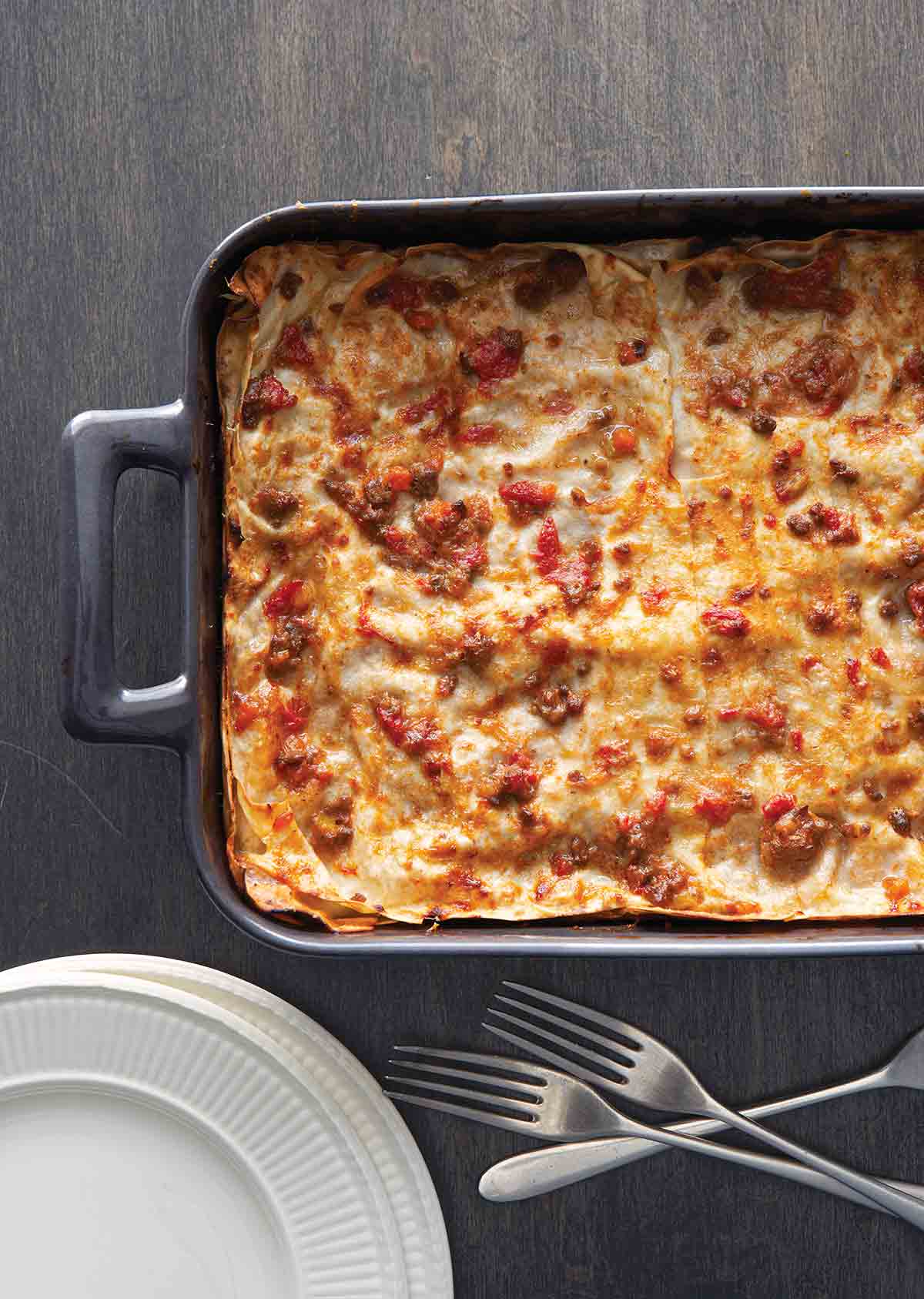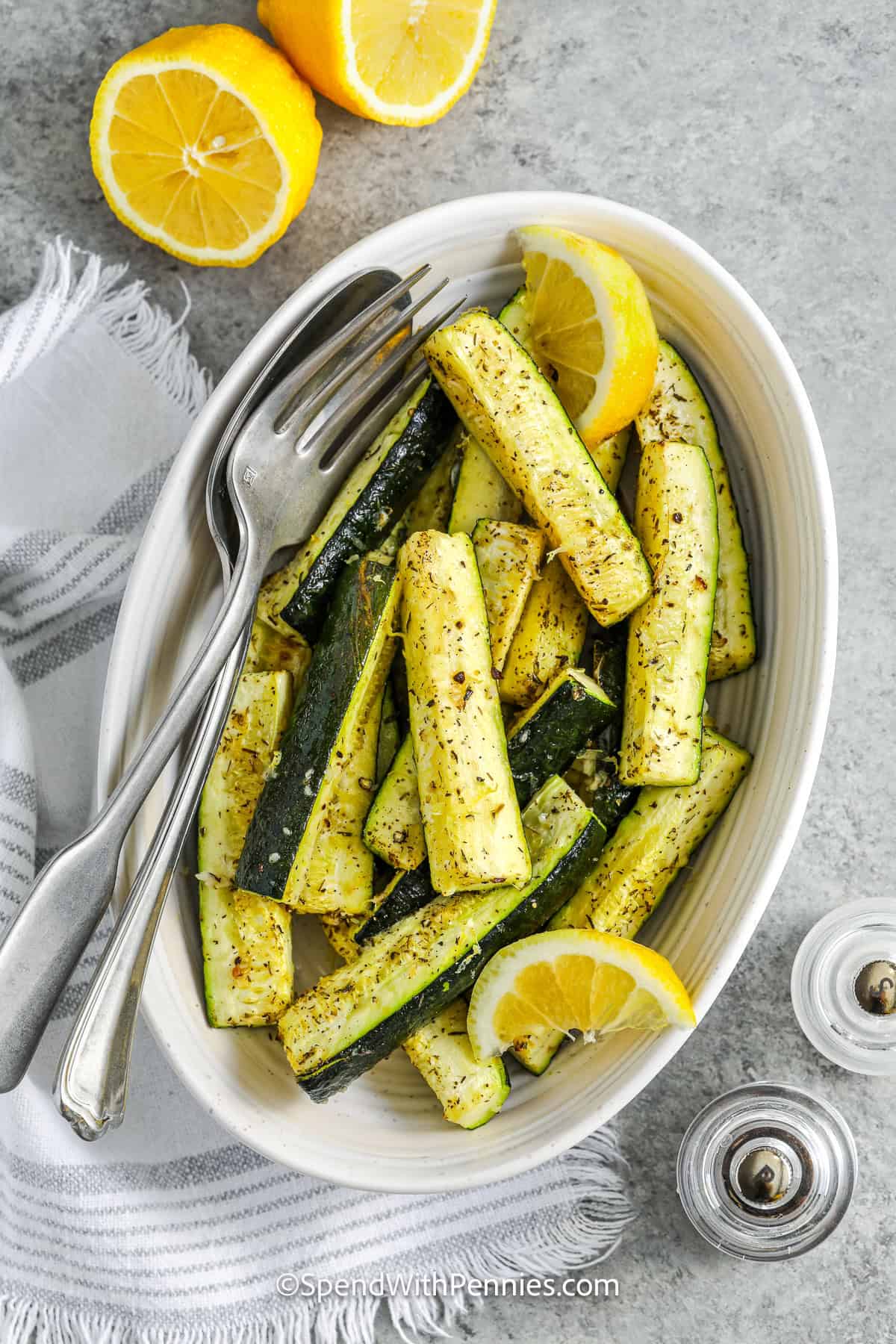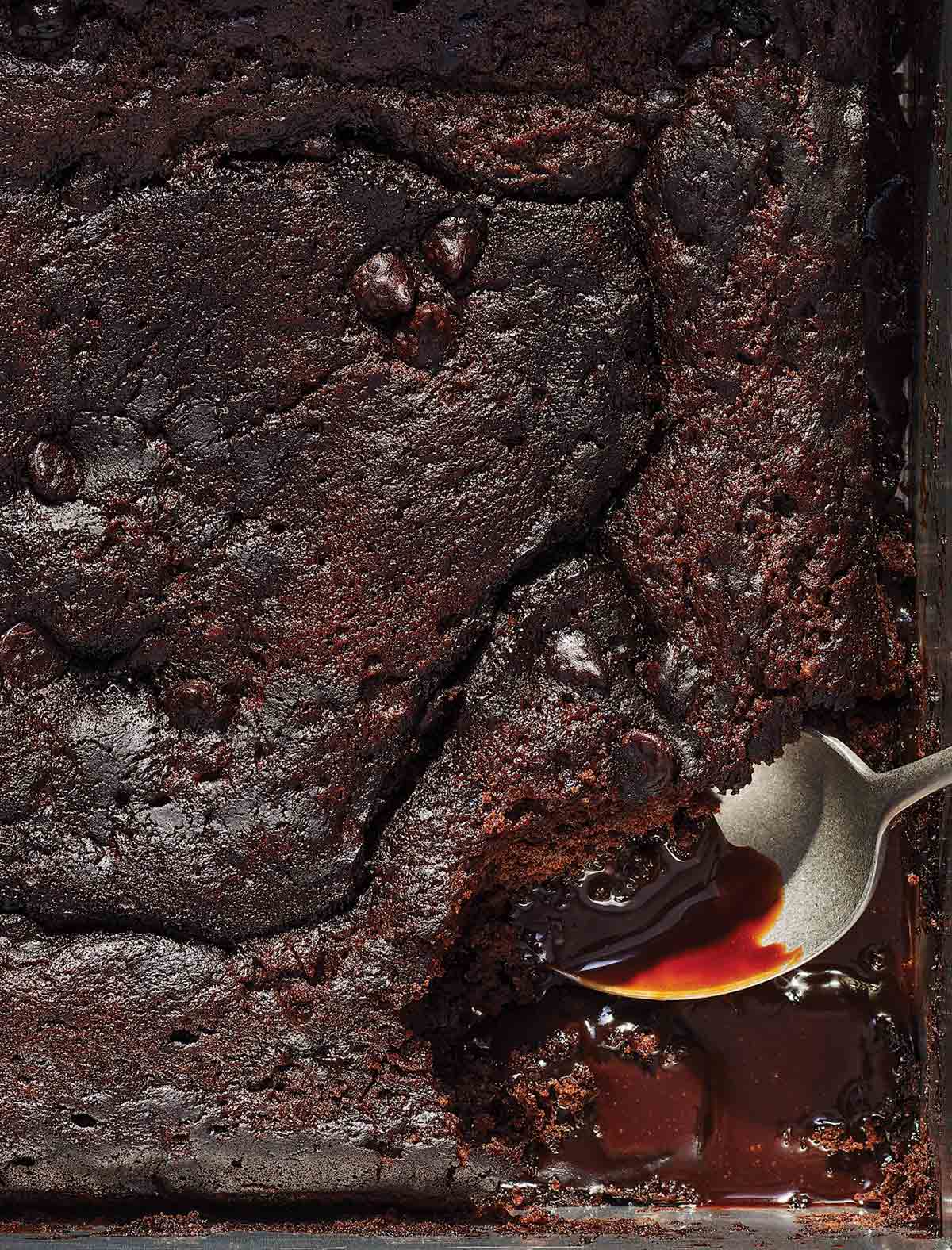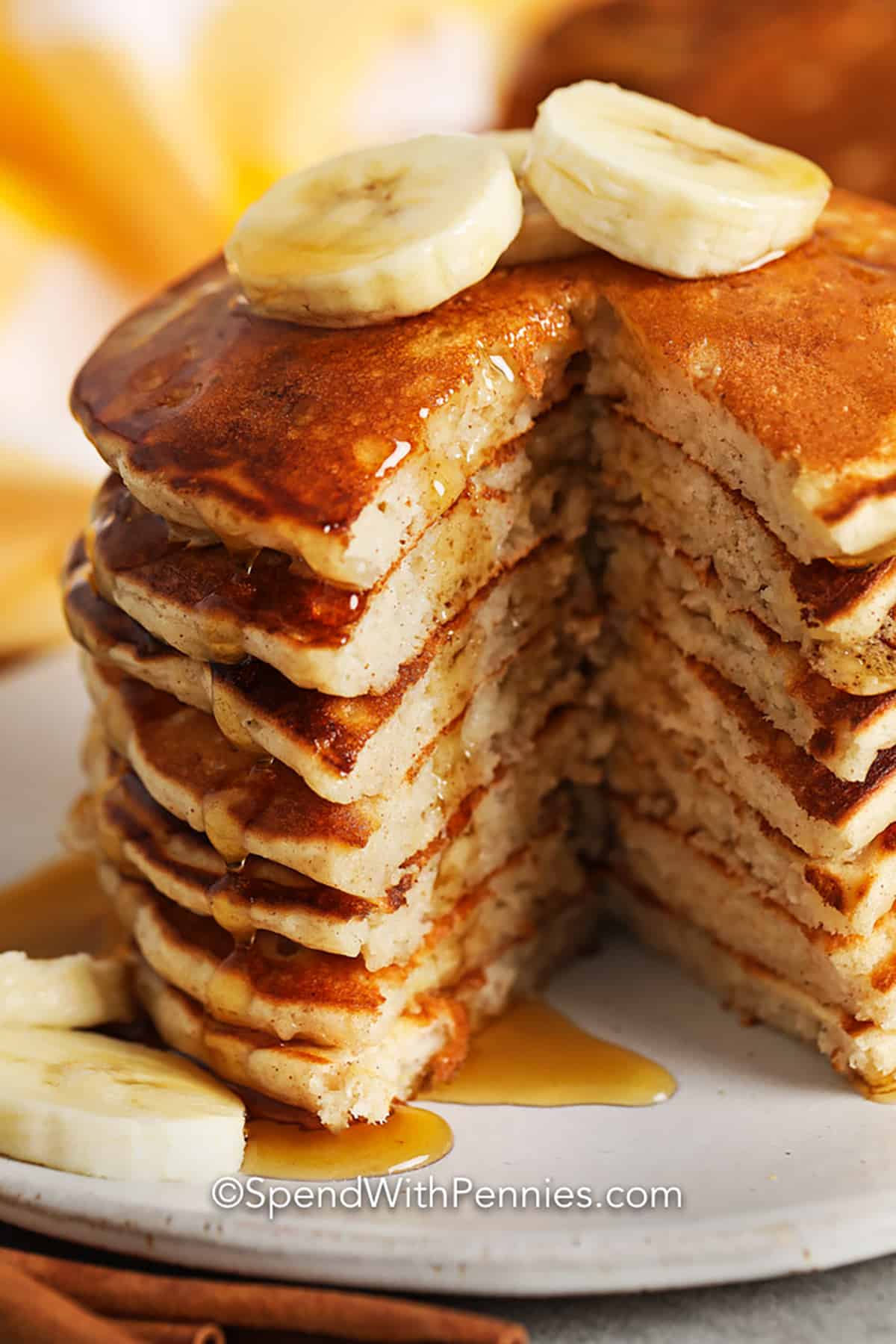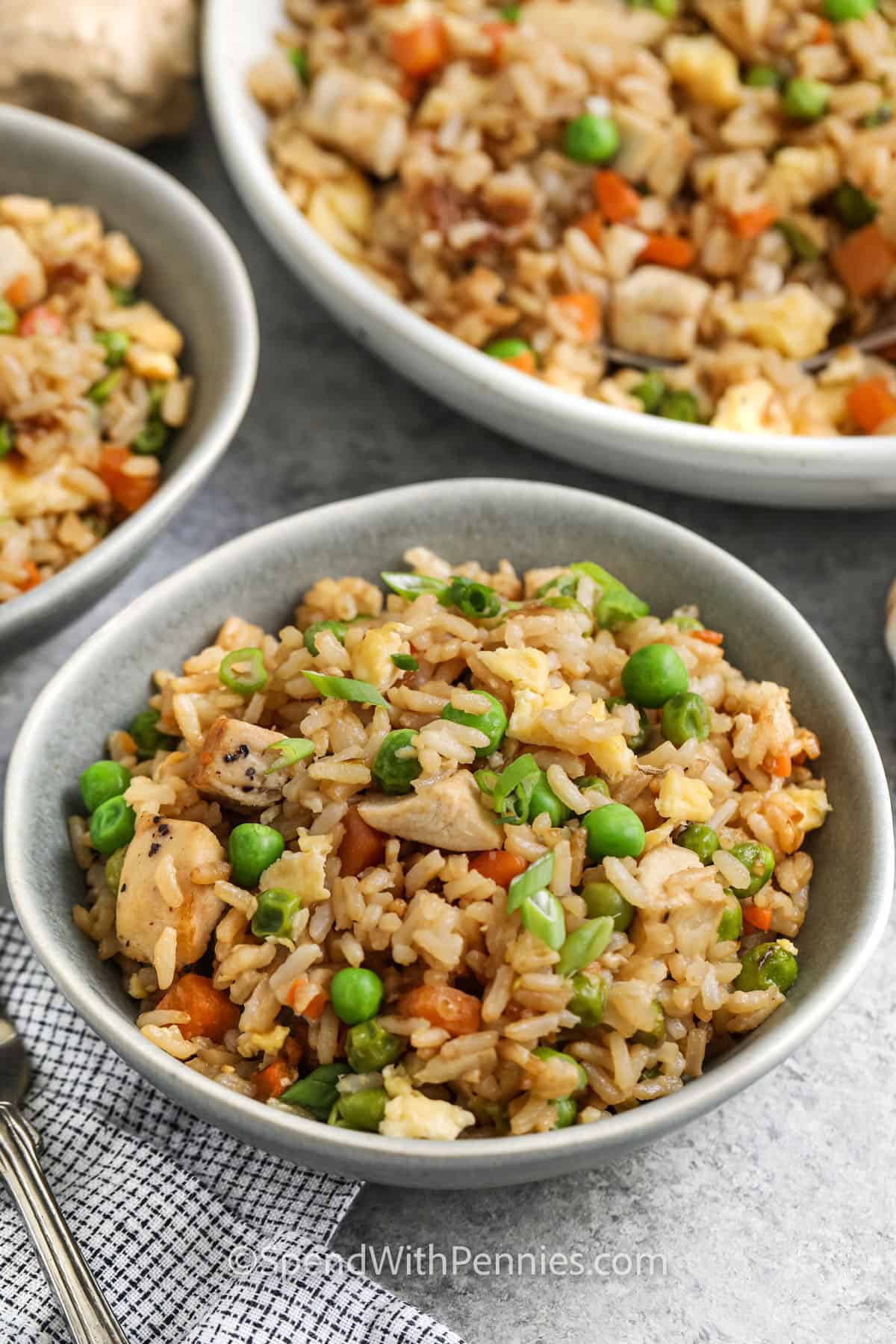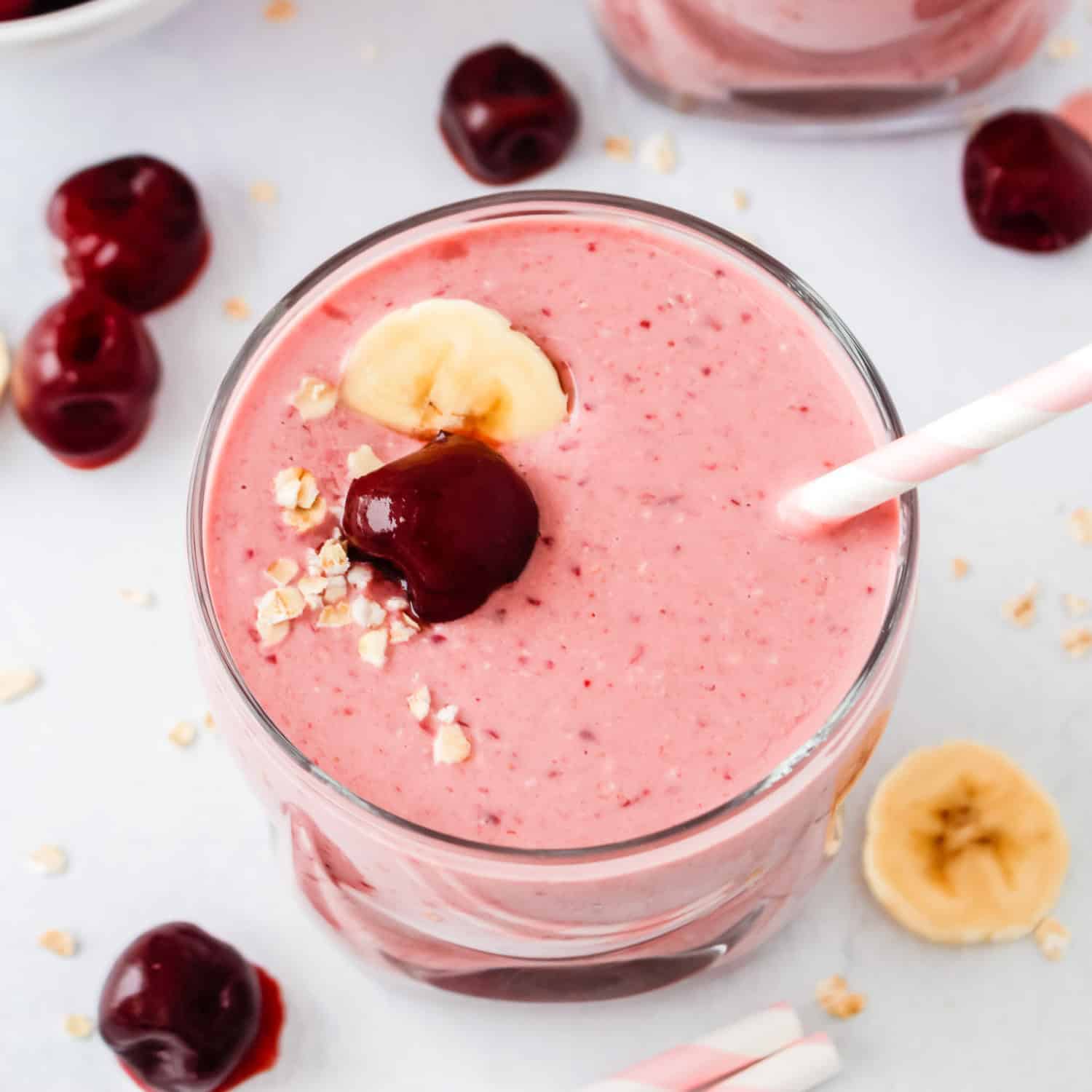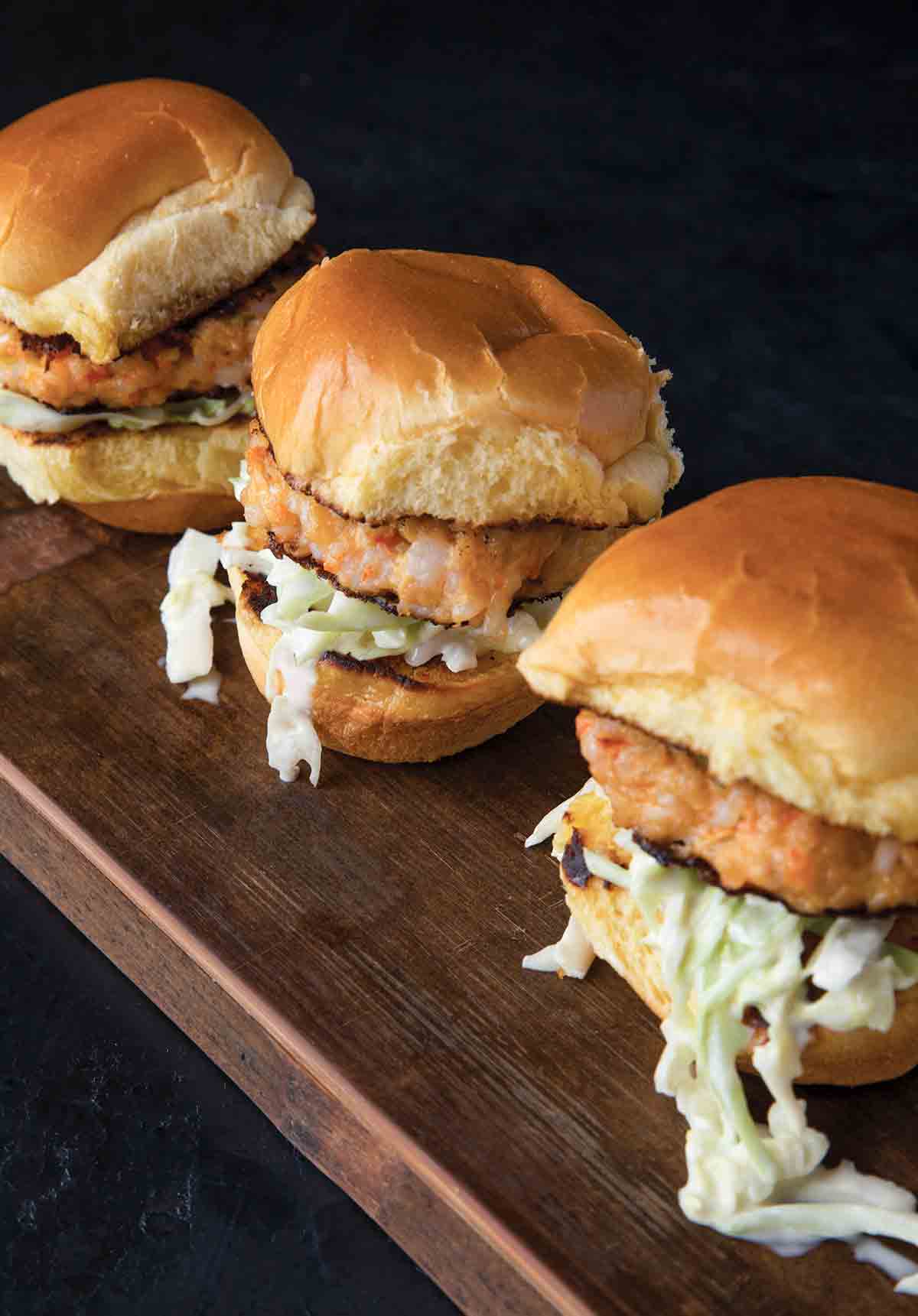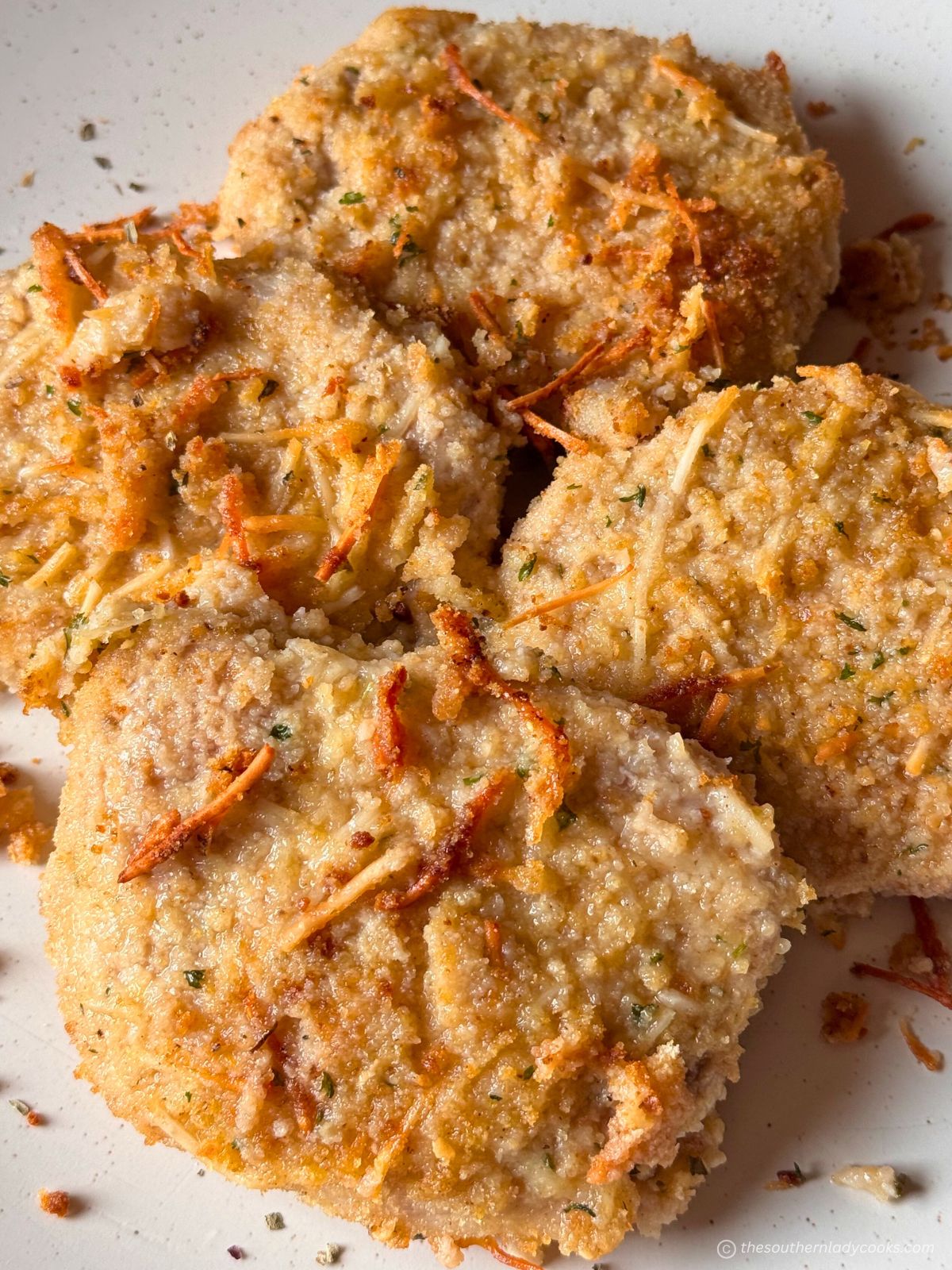Lasagne Bolognese
By Leite's CulinariaIngredients
1/2 medium yellow onion
1 medium carrot
1 stalk celery
3 tablespoons (1 1/2 oz) butter
2 tablespoons extra-virgin olive oil
12 ounces ground beef (preferably chuck)
1/2 cup dry white wine
1/2 cup whole milk
1/8 teaspoon nutmeg
2 cups canned whole peeled tomatoes with their juices
1 1/4 teaspoons salt
2 1/4 cups all-purpose unbleached flour
3 eggs
2 cups whole milk
4 tablespoons (2 oz) butter
4 tablespoons flour
1/2 teaspoon salt
Salt (for the cooking water)
3/4 cup freshly grated Parmigiano-Reggiano
1 tablespoon (1/2 oz) butter (cut into pieces)
- Prep Time60mins
- Cook Time240mins
- Servings6
Instructions
Make the Bolognese meat sauce
Peel and finely chop the onion. Peel the carrot and celery and cut into 1/4-inch dice. Place the onion, carrot, celery, butter, and olive oil in a heavy-bottomed sauce pot over medium-high heat. Sauté, stirring occasionally, until the vegetables are lightly browned, about 10 minutes.
Add the ground beef and break it up with a wooden spoon. Add the wine and cook, stirring occasionally, until almost half the liquid has evaporated. Add the milk and nutmeg and cook, stirring occasionally, until half the milk has evaporated.
Coarsely chop the tomatoes and add them along with their juice and the salt to the pot. Once the tomatoes have started bubbling, turn down the heat to very low so that the sauce is barely simmering. Cook, uncovered, for 3 hours, stirring every 15 to 20 minutes. If all the liquid evaporates before the cooking time is up, add water in 1-cup increments as needed. Make sure all the liquid has evaporated before removing the sauce from the heat. (You can prepare the sauce ahead of time and refrigerate it for up to 3 days or freeze it for up to 2 months.)
Make the pasta
Pour the flour in a mound in the center of your work counter. With your fingers, dig down in the center of the flour and when your fingers reach the counter, push the sides out to make a well in which the eggs will fit comfortably. (It's better to make the well a little wider than necessary than too small and risk the eggs overflowing.)
Break the eggs into the center of the well. Using a fork, beat the eggs as if you were making scrambled eggs until the yolks and the whites are thoroughly blended together. Use the fork to mix a little flour from the bottom of the inside walls of the well into the eggs. Continue until the mixture thickens enough to cling to the fork when you lift it into the air. Use your fingers to squeeze the dough attached to the fork back into the well and set the fork aside. Push about 1/4 cup flour to the side, then use your hands to bring the rest into the center of the well. Mix together with your hands until a dough that clings together begins to form. If the dough feels sticky when you plunge a finger into it, add a little more flour. The dough should feel moist but not sticky. Wrap the dough in plastic wrap (the surface of the dough can begin to dry out in as little as a minute) and then scrape off any bits of dough that have stuck to the counter. Reserve any remaining flour off to the side.
Unwrap the dough and begin kneading it. Think of stretching the dough rather than compressing it by using the heel of your palm and pushing away from you. Knead until the dough feels homogeneous and smooth. If it seems to stick to your hand or to the counter, add a little more flour. On the other hand, if it feels too hard to knead, you may have added too much flour. Try wetting your hands and kneading the moisture in. If that doesn't seem to help, it's probably easier and faster to start over. If you don't need to add any more flour while kneading, it should only take 5 to 6 minutes. Adding flour during the kneading process may increase the time since the further along you are, the longer it takes for the flour to get incorporated. When you've kneaded the dough sufficiently, wrap it in plastic wrap again and let it rest for at least 15 minutes or up to 3 hours. Never refrigerate or freeze pasta dough. As the dough rests, the gluten in the flour will relax, making it much easier to roll the dough.
After the dough has rested, unwrap it and knead it a few times to incorporate the moisture that inevitably rises to the surface. The surface of the dough at this point should feel silky smooth (a baby's bottom is the traditional comparison).
Cut the dough into 4 pieces. Wrap 3 of the pieces in the plastic wrap. Flatten the remaining piece of dough as best you can with your hands then put it through the rollers of the machine set at the widest setting. Fold the dough in 3, and put it through the rollers again with the folds perpendicular to the rollers. Fold the dough in half and put it through one more time, again with the folds perpendicular to the rollers. Lay the dough on a towel and repeat the procedure with the remaining 3 pieces.
When all the pieces have been through the machine at the widest setting, adjust the rollers down one notch and put each piece of dough through once. Repeat, going down one notch at time, until you reach the next to last setting. Cut each sheet of pasta in half, then put each piece through the machine at the thinnest setting. Wrap the pasta in plastic wrap and set aside to rest.
Make the béchamel sauce
Pour the milk into a small saucepan and place over medium heat until steam is released when the milk is stirred. This happens just before it comes to a boil.
While the milk is heating, melt the butter in a 2-quart saucepan over medium-low heat. Add the flour, mixing it in with a whisk until the mixture is smooth. Cook, whisking constantly, for about 1 minute. Do not let the flour brown. Remove the pan from the heat.
When the milk is hot, transfer it to a measuring cup or pitcher with a spout. Return the pan with the flour mixture to medium heat and begin adding the hot milk, very slowly at first, mixing with the whisk. Do not be concerned if the mixture becomes quite thick at first. Continue adding the milk slowly while mixing with the whisk. As the consistency becomes thinner, start adding the milk more rapidly until all of it has been mixed in. Add the salt and cook over medium heat, still whisking constantly, until the sauce begins to thicken, 10 to 15 minutes. The sauce is done when it coats the whisk thickly. (You should have about 2 cups.) Béchamel is best when used the same day but will keep overnight in the refrigerator if necessary. It's not necessary to reheat it before using.
Assemble the lasagne
When the Bolognese sauce is ready, fill a pot for the pasta with at least 6 quarts water, place it over high heat, and bring it to a boil.
Fill a large bowl halfway with ice and water and keep it close to the pot of water on the stove.
Add 2 tablespoons salt to the boiling water and carefully add 4 of the pasta sheets. Cook for 1 minute, then gently lift the pasta out of the water using rubber-tipped tongs and a spatula (so as not to rip the pasta sheets) and place the pasta in the bowl of ice water. Gently swish the pasta sheets in the water, then lay them flat on dry towels. Repeat with the remaining 4 pasta sheets.
Preheat the oven to 425°F (218°C).
Spread a thin coating of béchamel on the bottom of an 8-by-11 1/2-inch baking dish. Mix the remaining béchamel with the Bolognese sauce and 1/2 cup Parmigiano-Reggiano.
Use the bottom of the baking dish as a template and cut a piece of pasta to fit it. Cut the remaining pieces of pasta the same size and reserve any scraps of pasta. Place 1 pasta sheet in the dish. If you miscalculated and the pasta doesn't quite cover the bottom of the dish, cut the scraps of pasta into smaller strips to cover any exposed area. Spread a thin coating of the filling over the pasta, then cover with another pasta sheet. Continue until you have 6 or more layers of pasta and filling, reserving a little of the filling to cover the top layer of pasta. Sprinkle the remaining 1/4 cup Parmigiano-Reggiano over the top and dot with the butter. (The lasagne can be assembled completely up to 1 day in advance and kept, well wrapped, in the refrigerator. Remove it from the refrigerator 1 hour before baking.)
Bake until the top of the lasagne is lightly browned, 20 to 25 minutes. Take the lasagne out of the oven and let it rest for 5 minutes before serving. (The lasagne will keep in the refrigerator after it is baked for up to 2 days.)
MainsOther popular recipes
Popular categories
- Burgers & Wraps
- Dips & Toppings
- Stews & Chilis
- 4th Of July/Memorial Day
- Accompaniment
- Adult Beverages
- Air Fryer
- Appetizer
- Appetizers
- Appetizers & Snacks
- Appetizers/Snacks
- BBQ
- Beef
- Beverage
- Beverages
- Biscuit
- Bread
- Breads & Muffins
- Breakfast
- Breakfast & Brunch
- Breakfast And Brunch
- Brunch
- Cake
- Cakes
- Cakes & Cupcakes
- Candy
- Casserole
- Casseroles
- Chicken
- Chicken / Poultry
- Chicken Recipe
- Chocolates
- Cobbler
- Cocktail
- Cocktails
- Condiment
- Condiments
- Cookies
- Cookies & Bars
- Cooking Basics
- Dessert
- Desserts
- Desserts & Sweet Treats
- Dinner
- Dip
- Dips
- Dips & Spreads
- Dressing
- Dressings
- Drink
- Drinks
- Drinks & Adult Beverages
- Easy
- Entree
- Fish
- Fish Recipe
- Fried Chicken
- Frostings & Sweet Sauces
- Garnish
- Grains & Pastas
- Gravy
- Grilling
- Ham
- Holiday
- Homemade Ingredients & Condiments
- Hors D'Oeuvres
- Ingredient
- Kitchen Basics
- Lunch
- Main
- Main Course
- Main Dish
- Mains
- Mains & Entrees
- Marinade
- Meal Prep
- Meatless
- Muffin
- Muffins
- One Pan
- Pancakes & Waffles
- Pancit
- Pantry
- Party Food
- Pasta
- Pie
- Pizza
- Pork
- Pork Recipes
- Pressure Cooker Or Instant Pot
- Pulutan
- Quick Breads
- Salad
- Salad Dressing
- Salad Dressings & Toppings
- Salads
- Salsa
- Sandwich
- Sandwiches
- Sauce
- Sauces
- Sauces & Marinades
- Seafood
- Seasoning
- Seasoning Mix
- Seasonings
- Sheet Pan Dinners
- Side
- Side Dish
- Side Dishes
- Sides
- Sides & Vegetables
- Slow Cooker
- Smoothies
- Snack
- Snacks
- Soup
- Soup Recipe
- Soups
- Soups And Stews
- Spice Mix
- Spices
- Spreads
- Starter
- Stew
- Thanksgiving
- Turkey
- Tutorial
- Vegetable
